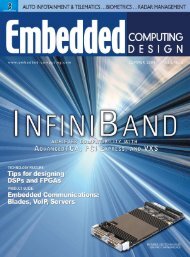CompactPCI and AdvancedTCA Systems - OpenSystems Media
CompactPCI and AdvancedTCA Systems - OpenSystems Media
CompactPCI and AdvancedTCA Systems - OpenSystems Media
You also want an ePaper? Increase the reach of your titles
YUMPU automatically turns print PDFs into web optimized ePapers that Google loves.
P R O D U C T G U I D E<br />
P A C K A G I N G<br />
performance, designers can optionally run<br />
multiple lanes in parallel. Allowable lane<br />
options include x1, x2, x4, x8, x12, x16,<br />
<strong>and</strong> x32.<br />
Two architectures:<br />
Tree <strong>and</strong> network<br />
PCIe can be used in two different system<br />
architectures as shown in Figure 2.<br />
CPU-to-I/O (tree)<br />
The first is a st<strong>and</strong>ard CPU-to-I/O communications<br />
bus, performing the same<br />
function that the PCI bus performs, but at<br />
higher speeds. This architecture assumes<br />
there is one, <strong>and</strong> only one, main CPU in<br />
the system. This CPU controls everything,<br />
from basic power-up to initialization, to<br />
running the main operating system. Other<br />
CPU components may provide intelligent<br />
I/O or secondary data processing, but<br />
there is always one main CPU.<br />
System-to-system (networking)<br />
The second usage model is a CPU-to-<br />
CPU (or system-to-system) networking<br />
model. In this model, PCIe will compete<br />
with other networking st<strong>and</strong>ards, such as<br />
Ethernet, but at a much higher speed. The<br />
key to using PCIe in a network model is<br />
the availability of Advanced Switching<br />
(AS). AS is an extension to the PCIe<br />
base specification that adds extra routing<br />
<strong>and</strong> protocol encapsulation information<br />
onto each PCIe packet. Intelligent<br />
switch chips, which allow boards that do<br />
not include AS logic to intercommunicate<br />
with others that do include the logic, add<br />
this extra information.<br />
<strong>CompactPCI</strong>e<br />
What’s the same, what’s new?<br />
<strong>CompactPCI</strong>e utilizes many of the same<br />
features as legacy <strong>CompactPCI</strong>, but<br />
changes the PCI bus for the new PCIe<br />
bus. Table 1 highlights the similarities<br />
<strong>and</strong> differences between the existing<br />
<strong>CompactPCI</strong> st<strong>and</strong>ard <strong>and</strong> the new<br />
<strong>CompactPCI</strong>e st<strong>and</strong>ard.<br />
The 3U <strong>and</strong> 6U form factors remain<br />
unchanged, <strong>and</strong> the same faceplates <strong>and</strong><br />
injector/ejector h<strong>and</strong>les are used. Chassis<br />
designs do not need to change with PCIe.<br />
However, the connectors used in the P1<br />
Figure 2<br />
<strong>and</strong> P2 area change, which means the<br />
backplane changes as well.<br />
New connectors<br />
<strong>CompactPCI</strong>e replaces the P1 <strong>and</strong> P2<br />
connectors used in <strong>CompactPCI</strong> with<br />
new connectors that occupy the same<br />
physical area. These new connectors<br />
provide more power connections, high<br />
speed differential pairs, <strong>and</strong> a path for<br />
hybrid slots, which can hold either legacy<br />
<strong>CompactPCI</strong> or the new <strong>CompactPCI</strong>e<br />
I/O boards.<br />
For 6U boards, the P3, P4, <strong>and</strong> P5 connectors<br />
remain unchanged from legacy<br />
<strong>CompactPCI</strong>. These connectors are commonly<br />
used for user I/O, rear I/O, <strong>and</strong><br />
Legacy <strong>CompactPCI</strong><br />
New <strong>CompactPCI</strong> Express<br />
Common features<br />
Board sizes<br />
3U <strong>and</strong> 6U Eurocard sizes<br />
Face plates <strong>and</strong> ejector h<strong>and</strong>les IEEE 1101.10 compatible<br />
Modular power supplies P47 based 3U <strong>and</strong> 6U modules<br />
Rear I/O<br />
Routed through P3, P4, <strong>and</strong> P5 connectors<br />
Same<br />
Secondary buses<br />
Routed through P3, P4, <strong>and</strong> P5 connectors<br />
Rear I/O<br />
Routed through P3, P4, <strong>and</strong> P5 connectors<br />
New features<br />
Bus PCI Multiple PCIe ports<br />
New connectors P1 <strong>and</strong> P2 for routing power <strong>and</strong> PCI bus XJ1, XP2, XP3, <strong>and</strong> XP4 for routing power <strong>and</strong> PCIe ports<br />
Voltages supplied 3.3 V, 5 V, 12 V, <strong>and</strong> –12 V 3.3 V, 5 V, 12 V, <strong>and</strong> 5 V auxiliary<br />
Table 1<br />
34 / <strong>CompactPCI</strong> <strong>and</strong> <strong>AdvancedTCA</strong> <strong>Systems</strong> / September 2005

















